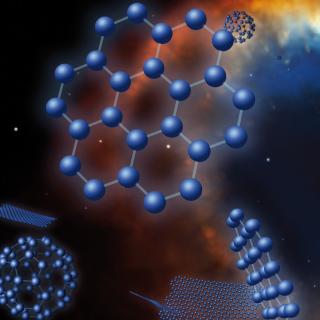Bibcode
Sahai, Raghvendra; Van de Steene, Griet; van Hoof, Peter A. M.; Zijlstra, Albert; Volk, Kevin; Dinerstein, Harriet L.; Barlow, Michael J.; Peeters, Els; Manchado, Arturo; Matsuura, Mikako; Cami, Jan; Cox, Nick L. J.; Aleman, Isabel; Bernard-Salas, Jeronimo; Clark, Nicholas; Justtanont, Kay; Kaplan, Kyle F.; Kavanagh, Patrick J.; Wesson, Roger
Referencia bibliográfica
The Astrophysical Journal
Fecha de publicación:
5
2025
Revista
Número de citas
3
Número de citas referidas
2
Descripción
The planetary nebula NGC 6720, also known as the "Ring Nebula," is one of the most iconic examples of nearby planetary nebulae whose morphologies present a challenge to our theoretical understanding of the processes that govern the deaths of most stars in the Universe that evolve on a Hubble time. We present new imaging with JWST of the central star of this planetary nebula (CSPN) and its close vicinity, in the near-to-mid-IR wavelength range. We find the presence of a dust cloud around the CSPN, both from the spectral energy distribution at wavelengths ≳5 μm as well as from radially extended emission in the 7.7, 10, and 11.3 μm images. From the modeling of these data, we infer that the CSPN has a luminosity of 310 L⊙ and is surrounded by a dust cloud with a size of ∼2600 au, consisting of relatively small amorphous silicate dust grains (radius ∼0.01 μm) with a total mass of 1.9 × 10‑6 M⊕. However, our best-fit model shows a significant lack of extended emission at 7.7 μm—we show that such emission can arise from a smaller (7.3 × 10‑7 M⊕) but uncertain mass of (stochastically heated) ionized polycyclic aromatic hydrocarbon (PAHs). However, the same energetic radiation also rapidly destroys PAH molecules, suggesting that these are most likely being continuously replenished, via the outgassing of cometary bodies and/or the collisional grinding of planetesimals. We also find significant photometric variability of the central source that could be due to the presence of a close dwarf companion of mass ≤0.1 M⊙.
Proyectos relacionados

Nucleosíntesis y procesos moleculares en los últimos estados de la evolución estelar
Las estrellas de masa baja e intermedia (M < 8 masas solares, Ms) representan la mayoría de estrellas en el Cosmos y terminan sus vidas en la Rama Asintótica de las Gigantes (AGB) - justo antes de formar Nebulosas Planetarias (NPs) - cuando experimentan procesos nucleosintéticos y moleculares complejos. Las estrellas AGB son importantes
Domingo Aníbal
García Hernández